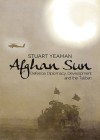Afghan Sun: Defence, Diplomacy, Development and the Taliban
Stuart Yeaman,
Boolarong Press, 2013,
ISBN 9781922109910, 360pp
Reviewed by: Colonel David Connery
Most books reviewed in this journal are written by detached observers and academics. Afghan Sun is different. It is the work of former Australian Army officer Colonel Stuart Yeaman, AM, and is a personal account of the unit he commanded in Afghanistan. This book will primarily interest readers with a connection to the unit or those with a deep appreciation of the Afghan conflict. Future commanders will also find sound advice on counterinsurgency and engineering operations presented through insights into Colonel Yeaman’s thinking and infrequently offered personal views.
Afghan Sun is a detailed narrative of Reconstruction Task Force 4 (RTF4) and its tour of Afghanistan from April to October 2008. The book covers the formation and training of the task force and its initial deployments. The story then moves in chronological sequence through the major construction operations which focus on the impressive deployments to build a new patrol base in the Baluchi valley and the long-range bridge repair effort in south-eastern Afghanistan. These stories illustrate the consideration, preparation and teamwork necessary for successful operations. They also describe how RTF4 commanders analysed risk, their mission and their enemy. The book is particularly strong in these areas, and the stories of each operation are conveyed clearly and crisply.
Providing context for the reader can be a tough task, particularly where the book only covers a small part of a large war. Yeaman provides this background by taking the reader through the ‘why’ of the conflict and the ‘who’ of some important actors in well-considered and logical ways. He mixes this element of the narrative with anecdotes describing former President Karzai’s links to the province, explanations of Afghan society, and details of military equipment and tactics. The latter section, told from an Army engineer’s viewpoint, is fascinating, particularly as this topic is rarely broached in the broader literature on warfare. As background, these sections perform adequately, although they are unlikely to satisfy those who seek a deeper understanding of Afghanistan and this conflict.
The narrative produces some sharp observations on the Afghan war and Australia’s role. Yeaman laments the lack of media coverage of the war and his unit, which he felt could have helped convince Australians to ‘own’ the war. While that outcome was always unlikely, it does highlight the general estrangement of the Australian people from the tough and dangerous task performed by their army. His observations on post-traumatic stress syndrome are poignant and his views on team-building and discipline are worthy of consideration by those who may undertake a similar job in the future. He provides some insight into the local level diplomacy and development in Uruzgan during 2008, but makes no real attempt to place either in their broader context or to evaluate their relative significance. That such advice and views are rare is disappointing, but generally consistent with the author’s narrative style.
Unit histories do not always make interesting reading for general audiences. They must balance the requirement to explain unit actions with the need to recognise those who were involved. Afghan Sun achieves that balance and is a worthwhile addition to the growing literature on this protracted and ongoing war.


